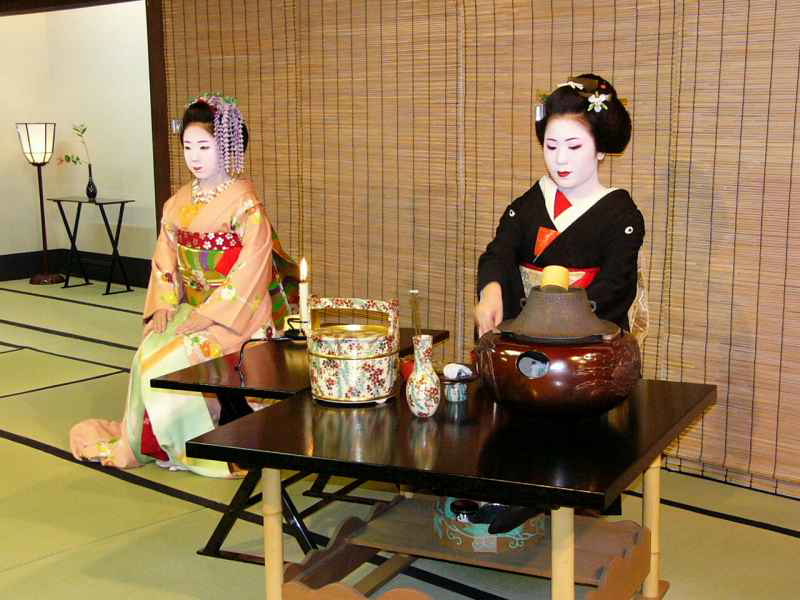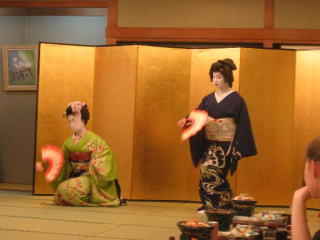Geiko (geisha) and maiko
Geiko芸子, geisha 芸者 and geigi 芸妓 are the same.
In Kanto area (around Tokyo), they call them "geigi" or "geisha",
and in Kansai (around Kyoto) geiko.
They entertain (dancing, singing and playing shamisen, etc.) at banquets
and socialize with guests.
A half-baked geisha-to-be is called "Hangyoku 半玉"...Han半 means half、their ability of dance is not perfect
so gyokudai (玉代/fee for call geisha) is half price. That's why they are called Hangyoku.
Hangyoku in Kyoto is called "Suugi 雛妓/Oshaku ". And after they brush up their skills they are called Maiko
and earn full amount of fee.
Then, after they get farther skill and reached the level, they are called
geiko.

|
| ↑maiko.......................................................................................↑geigi/geisha/geiko |
"Geisha"is one of the first things that foreign people image
when they mention Japan.
Geisha is a female professional entertainer.
A geisha in Kyoto are highly accomplished in traditional manners and artistic
performance.
 |
| left: maiko........right: geiko (geisha) |
They play the shamisen (Japanese banjo), sing traditional song ( kouta,
etc.)
and perform Japanese dances at a Japanese-style banquet etc.
They also play games with guests, pour drinks,
and make guests enjoyable with excellent conversation.
"Maiko" is a girl geisha-to be in Kyoto.
They wear beautiful long sleeve colourful kimono.
The way of tying obi or sash is called "darari "and it hangs down.
Today only maiko tie the sush like that.
They wear very thick-soled clogs called pokkuri.
(Maiko is apprentice geisha in Kyoto.
In Tokyo, they are called Hangyoku )
*************
There are three Maiko and eighteen Geigi in Nagoya (Jan. 2011)
In 2009, Meigiren (名妓連 Nagoya Geigi Association) had a teenager-Maiko for the first time in
20 years.
Her name is Yukino (ゆき乃) and she is so pretty.
As a Nagoyan Geigi, they have to learn at least two special performances
aside from traditional Japanese arts.
One is to sing "Nagoya Jinku"(Jinku is one of Japan's folk songs
and is
fixed verse form of 26 syllables arranged in a seven-seven-seven-five pattern.)
The other is a performance to make a shape of "Gold shachihoko"
of Nagoya Castle (Top of
the roof of danjon, you see a pair of shachihoko/The gold shachihoko is
a symbol of Nagoya)
by standing on both arms and a cheek
Photos are here (external link)
***
If you want to see Nagoyan geigi's performance, you have to reserve
Ryotei (Japanese restaurant) and call them.
Minimum charge: 20,000 yen /2hours plus transportation fee for geigi.
(For traditional Japanese hairdo and kimono with train, you will be charged
extra)
Meigiren Official Website is here.
Traditional style Japanese restaurant called "Ryotei" (Everything
is very expensive.)
Hassho-kan(八勝館) Yagoto, Showa-ku
Kawabun(河文) Marunouchi, Naka-ku
Tsutamo(蔦茂) Sakae, Naka-ku
Kouraku (香樂) Chikara-machi, Higashi-ku
|
**********
| Geisha jargon |
Ito
糸 |
Shamisen (Japanese banjo) |
Kagai/Hanamachi
花街 |
Geisha quarter |
Okiya
置屋 |
Business office dwelling of geisha |
Hakoya
箱屋 |
Man who carries geisha's shamisen. |
Ozatsuki
御座付 |
Greetings to the customers when they visit the ozashiki.
Usually they sing or dance concern to the local area or season in salute. |
Ocha o hiku
お茶を引く |
Situation that geisha is not busy
When geisha who had not many customers to named her passed the time griding
the tea to make powdered green tea (matcha) |
Gyokudai
玉代 |
Time charge for a geisha. |
Senkodai
線香代 |
Fee for a geish's time. Senko means incense stick..
In the old days, they timed with a burning incense stick.s |
Tachikata
立方 |
Dancing geisha |
Jikata
地方 |
Geisha who play the shamisen at a banquet |
Kemban
検番/見番 |
Geisha call-office made up of the
associations of caterer, geisha dwelling and teahouse
They take charge of all arrangement: arrange of geisha, take geisha to
and from the
machiaijaya, arrange and adjust the charge, etc. |
Genjina
源氏名 |
Professional name used by geisha |
Meigi
名妓 |
Talented or beautiful geisha |
Tsukeppanashi
つけっぱなし |
No time restriction on geisha-asobi. |
Daijin Asobi
大尽遊び |
Play around in grand style at the geisha quarter |
Ozashiki-Asobi
Ozashiki Culture College


